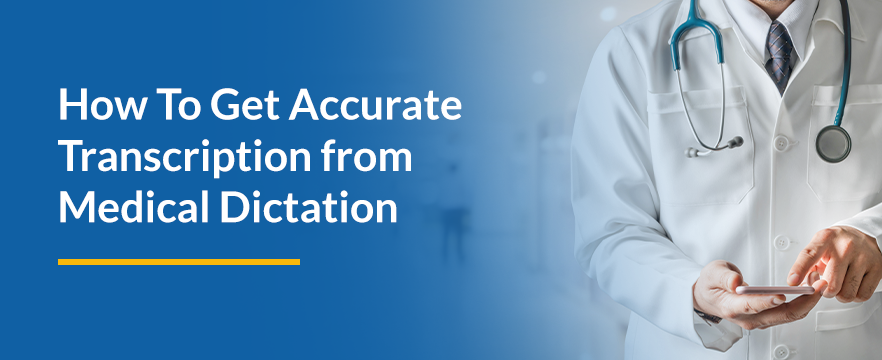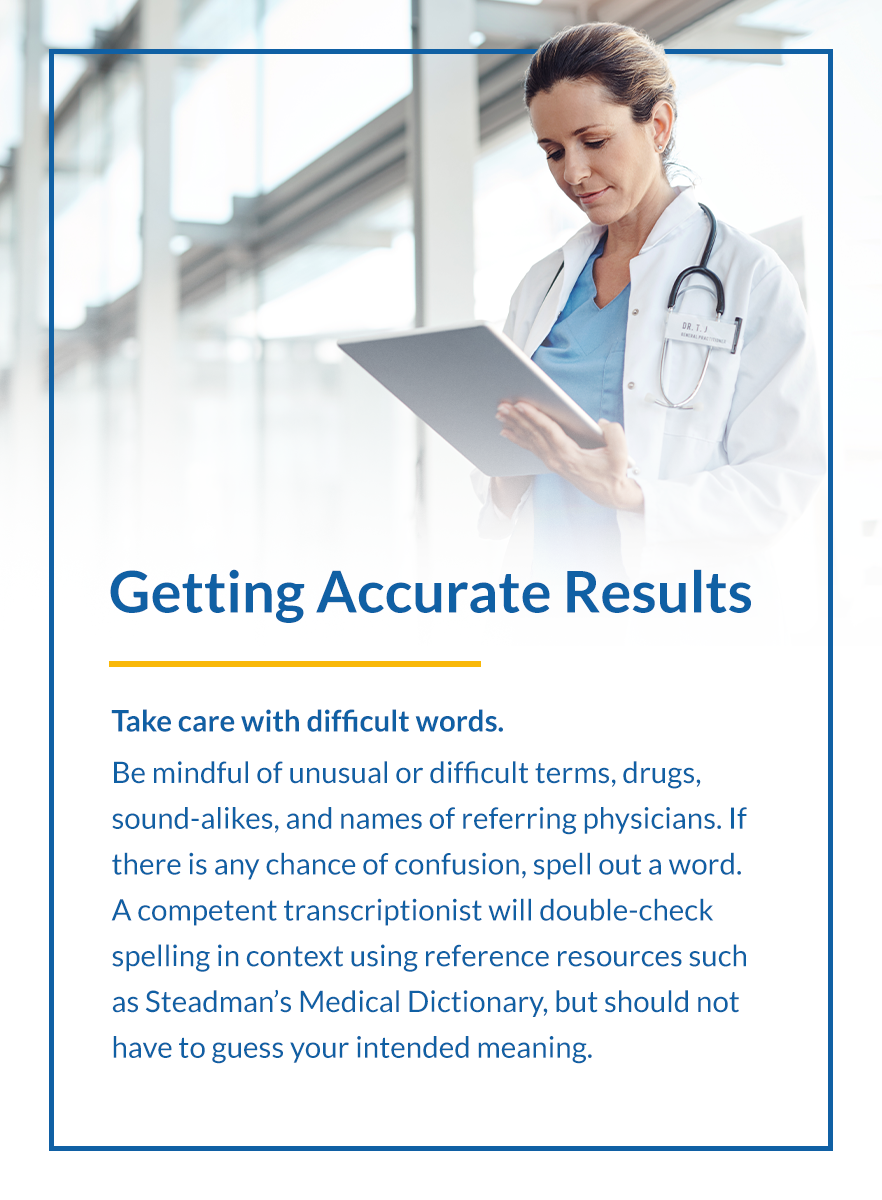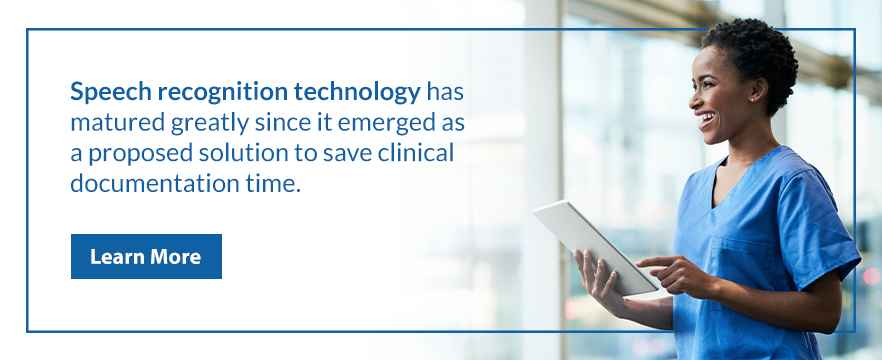How To Get Accurate Transcription from Medical Dictation
Feb 03, 2016 | Jonathan Maisel
Accurate transcription of clinical notes starts with good dictation, but there are many other factors that also contribute to transcription quality. As a physician or medical facility using dictation, you are all too aware of the potentially serious legal, financial, and patient health impacts that transcribing mistakes can cause. Transcribed reports are part of the medical record and must be highly accurate. Downstream uses such as coding for billing, backup for potential audits, or Meaningful Use attestation, are also dependent on the integrity of clinical documentation. The following tips provide helpful guidelines for getting accurate results from your transcription service.

-
- Speak clearly. Talk in a conversational tone at a normal rate. Getting the dictation done faster is not the goal, quality documentation is.
- Speak to the mic. Depending on the type of microphone used, the recorder should be about 3/4″ from the mouth in an upright, level position so that sound goes over the top of the microphone and not directly into it. If using a smartphone or tablet as a recording device, know where the mics are and make sure they are not covered with your hand. In some cases a smartphone will have multiple omnidirectional mikes.
- Avoid noisy environments and distractions. Choose a quiet, secure location to record from. Dictating in a quiet and secure environment will significantly improve results and maintain patient confidentiality. Avoid areas prone to background noise and distractions. Other voices talking, telephones ringing, overhead speakers, music, vacuums, and beepers in the background can obscure the intended dictation. If you have to dictate in an outdoor location, avoid traffic noise. Wind, even a slight breeze, can compromise audio quality.
- Dictate promptly. The best time to dictate is soon after your patient encounter, so that the information is fresh in your mind and possibly more complete.
- Interruptions will happen, but don’t record them. Overlapping dialogue in the background will make your dictation hard to hear and follow. If you are called into another conversation or experience another temporary interruption, hit PAUSE on your recording device and return to your dictation when you are no longer distracted. In some systems, hitting STOP will create a new audio file, and you must re-dictate the patient’s name to continue.
- Take care with difficult words. Be mindful of unusual or difficult terms, drugs, sound-alikes, and names of referring physicians. If there is any chance of confusion, spell out a word. A competent transcriptionist will double-check spelling in context using reference resources such as Steadman’s Medical Dictionary, but should not have to guess your intended meaning. If words cannot be transcribed, leaving blanks in the transcript, then extra turnaround time, staff, and costs will be incurred before the document can be completed.

- Clarify numerical descriptions and units of measure. Pay special attention to numbers and measurements. Separate all individual numbers. (Appropriate to the meaning, either say, “One hundred twenty-six” or “one hundred twenty milligrams of [x] and six milligrams of [x]”.) Clearly state dosage units to avoid misunderstandings such as “milligram” vs. “microgram,” which could cause an error leading to irrevocable patient harm.
- Don’t run words together. Small words can change meaning, but may be lost if glossed over by being spoken too quickly. “The patient has no history of asthma” is very different from the same sentence without the word “no.” If the transcriptionist misses hearing the negative, the erroneous transcription could impact care coordination and clinical decision making, with adverse consequences for the patient, and possible litigation for the physician.
- Know how to use your device. Be familiar with your recording device, so you know how to access the basic functions such as RECORD, PAUSE, STOP, INSERT, OVERWRITE, SEND. Practice with several test dictations.
- Learn how to access the dictation system. Know the call-in or log-in procedures, including your I.D. credentials. Ask for a “cheat sheet” with user instructions. Most MTSOs will also provide a pocket-sized instruction card that you can carry with you.
- Turn the recorder on and wait a beat. Make sure your device is powered on, and in RECORD mode. It can take a few seconds for the dictation/recording to begin, so give it a moment before you start to speak. Note that with some handheld USB recorders, words or phrases may be “cut off” if the dictation and button activation are performed simultaneously.
- Set up approval protocols in advance. If you are using electronic signature, provide the MTSO ahead of time with the appropriate permission in writing and a copy of your handwritten signature if appropriate.
- Start with complete, accurate demographics. Patients must be correctly and unambiguously identified. Have all pertinent information available during the time of dictation. Always begin dictation by identifying the patient, the medical record number, appropriate dates, and the report type (or work type). Two types of identification must be dictated for each report, such as the patient’s name and medical record number, in order to avoid documenting for the wrong patient (who may have a similar name, for instance). An MTSO should be capable of accepting an ADT feed if available from your facility.
- Make sure the MTSO has updated lists of names. The transcriptionist or MTSO should have a complete list of physician names, including dictating authors and referral doctors, before any transcription begins. An omission in these names will delay your expected turnaround time. A contact at your facility should be available for related questions at all times, either by phone, fax, or email.
- Note special instructions first. Provide any special instructions at the beginning of the dictation.
- Create a new file for each dictation. Do not “piggyback” reports by recording more than one dictation on a single audio file. Create a single audio file for each document, by pressing STOP after each dictation. This will reduce the chance of lost dictation.
- Create a new audio file in the event of later amendments. If you need to add to or amend a dictation at a later time, create a new audio file. State the patient’s name and indicate if you would like the typist to add something to a previously dictated report, or if you want a separate report labeled as an amended report.
- Send encrypted files only. HIPAA patient privacy and information security regulations mandate severe penalties for breaches. Your audio files must be encrypted for transmission to your transcription provider. In general, email is not considered a secure means of transmission. Always follow your facility’s and MTSO’s protocol for sending and receiving electronic audio files. If the dictation is very long, or the file is very large, the MTSO may provide proprietary software (such as ZyDoc’s “ZyFile”) for such transmissions.
- Use qualified transcriptionists. Most well-qualified transcriptionists can successfully understand a wide spectrum of accents and ESL dictators, to a point. In evaluating a transcription service, ask what experience the transcriptionists have with this type of dictator (dictating authors), and if in doubt, submit a sample dictation as a test. Assuming that accents are not a problem, and standard English is the norm for your organization, then speed, clarity, audio volume, and environment are the top considerations related to recording quality.
- Learn about Quality Assurance. When evaluating an MTSO, ask what quality assurance measures are in place, and what guarantees are offered. A reputable, full-service transcription service will review transcriptions for any errors, including critical and major errors. According to the Association for Healthcare Documentation Integrity (AHDI), “critical errors are those which could compromise patient safety or continuity of care. Major errors are those which could compromise the integrity of a note without risk to patient care.” 1 An accuracy rate of 95-98% is considered acceptable, although your facility’s requirements may differ.
- Provide feedback. Timely feedback is essential when working with a new transcriptionist, and continues to be important if an issue arises. Corrections should be performed for free prior to final approval. Changes due to author error (“dication error) or amended information generally incur a charge.
Good Dictation and Work Habits are Key For Accurate Transcription from Medical Dictation
Using speech to document encounters is more natural than using a keyboard and mouse. In a recent NIH-supported research study by ZyDoc, clinical dictation was shown to be an average of 2.5 times faster than typing. Although speaking is a more natural modality, good speech habits when dictating may need to be learned. Fortunately, dictating effectively is a skill that is easily learned.
Beyond generating clear audio, achieving excellent transcription results also requires attention to workflow details such as providing complete and correct information, clear identification of any STAT or amended reports, alerting the transcriptionist to special instructions, and secure transmission of files. Getting this aspect right saves time and frustration for both the author and the transcriptionist, and reduces the potential for errors.

Speech Recognition Technology as a Proposed Solution To Save Clinical Documentation Time
Speech recognition technology, or “SRT,” has matured greatly since it emerged as a proposed solution to save clinical documentation time. Front-end SRT allows an author to dictate, view the appearance of the text onscreen with minimal lag time, and perform immediate edits. Back-end SRT, usually considered more accurate, is accomplished by converting speech to text after completion of a dictation session for subsequent routing to a transcriptionist or editor, who then reviews, corrects, or in some cases, re-types the report. A speech recognition system that incorporates no human review is not currently available with the level of accuracy needed for clinical documentation. Front-end, or preferably back-end, SRT may be cost-effective and feasible for certain organizations, and is generally deployed as a component of an integrated transcription system such as Philips SpeechExec, and/or for dictation into an EHR.
For more information about ZyDoc transcription and MediSapien structured data services, including EHR insertion, please click here or call 800.546.5633 ext. 708. ZyDoc is a certified Philips reseller.

